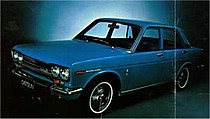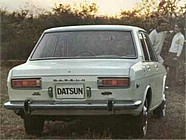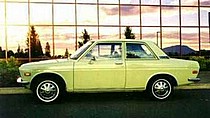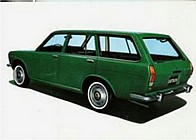
When first shown, at the 1967 Tokyo Motor Show, Japanese customers received the overhead-camshaft 1.3-liter engine with a claimed 72 PS (53 kW) – according to Nissan, an engine more capable than competitor Toyota’s 1.5-liter version. The little engine was not helped by being married to a three-speed manual gearbox. From the beginning, however, North American customers received the larger 1.6 coupled to a four-speed all-synchro transmission. Indeed, by October 1968 the Bluebird was made available with a 1600 cc engine to Japanese buyers as well.
The 510-series Bluebirds differed widely depending on the market. In South America, Asia (excluding Japan), and in Africa, the 510 sedan, two-door, and station wagon models traded rear independent suspension for a leaf-sprung solid axle. The engines for these markets also differed. Rather than the OHC L-series, they received pushrod inline four-cylinder engines from the J-series with either 1.3 or 1.5-liters displacement. These variants were also known as Datsun 1500 (J15 engine) and Datsun 1300 (J13 engine).
1972-1973 Datsun Bluebird 1400 Deluxe (510N, Japan)
In September 1970, the 1.3 and 1.5-liter engines were replaced with 1.4-liter units. In September 1971 the new, larger, Bluebird U (610) appeared in Japanese showrooms, but the 510 continued on sale as a lower-priced, more compact version. It also received a minor facelift with plastic surrounds for the headlamps, while the 1800 cc models were discontinued. The chassis code was changed to 510N.
North America
Originally only available as a four-door sedan or a station wagon for the 1968 model year, the two-door sedan saw a limited introduction during the summer of 1968 – making this the rarest U.S. 510 year and model. The two-door sedan body style became popular and was imported into the U.S. and Canada in large numbers for the next five model years. The Datsun 510 released to the North American market had a Hitachi downdraft-carbureted 1.6-liter L-series straight-four engine, with an advertised gross power of 96 hp (72 kW), a claimed top speed of 100 mph, front disc brakes, four-wheel independent suspension (MacPherson struts in front and semi-trailing arms in rear), except the wagons, which used a rear solid live axle with leaf springs.
The 1968 510s are quite different from the later model years; they have a stainless steel grille, wipers that operate in a “clap-hand” pattern, small amber front turn signals, no rear side marker lights, and different taillights from later models (without chrome trim). For 1969, the grille was changed and now has an unpainted, stainless steel central section with rounder bars than those found the year before. The wide “DATSUN” text was replaced with an upright rectangle with a “D” in the middle. The windshield wipers were changed for a more traditional layout and round side marker lights were added at the rear. Larger taillights, all red with a small, white reversing lamp, were introduced and remained until the end of production. The interior saw minor changes; most importantly the ignition was moved onto the steering column. All North American model 510s received anti-sun glass from 1970 on.
n Canada and the U.S., unitized-body Datsun PL510 cars have become rare in the Rust Belt regions, but can still be seen in areas where corrosive materials are not generally used on the roads- such as Western and Southern States. The greatest numbers of the cars seem to be in the West Coast region, where Japanese cars first succeeded in the market.
Europe
As well as American and Oceanic markets, the 510 was also imported into Europe. First imports were delivered shortly after the announcement of the car in Japan and was one of the models to spearhead the brand. The first UK imports were announced at the October 1968 Motor Show. The first models were the L16 saloons, with the estate versions following shortly after. L13 models arrived in early 1969, and a series of minor updates and equipment changes followed – as dictated by the changes made for the US market. The L14 model replaced the L13 in October, 1970, and was imported with the L16 until May, 1972, when the car was replaced by the far more successful (in the UK) 610. Nissan imported about 4000 510 models into the UK, and less than 10 of those original UK spec cars are known to exist. Nissan established a proper dealer network around the time the 510 was discontinued, (Octav Botnar was instrumental in the massive success of the brand in the UK) so the 510 never really received the marketing nor recognition that was achieved in other countries. All official imports in the UK were four-door saloons or estates, but several two-doors and at least one four-door SSS version are in the country.
Oceania
Australian versions of the Datsun 1600 were delivered either as a full import (1967 and early 1969), or assembled in Australia from local and Japanese parts. These 510 Datsuns were equipped with L16 engines. Australia officially received only the four-door sedan and station wagon models. The last of the P510 series went through Australian assembly lines in 1972, and due to the extensive use for rallying, the cars are now quite hard to find in any reasonable condition.
Nissan-Datsun New Zealand had the four-door manual sedans assembled locally from 1968, replacing two generations of Bluebirds (the name continued to be used in Japan and elsewhere) with the new 1600 export badge. Local content was about 40% and included glass, wiring, batteries, radiators, carpet and interior trim. Locally made radios were a dealer-fit accessory. The cars were built under contract at Campbell Motor Industries in Thames; the preceding Bluebird had been built at NZ Motor Bodies in Auckland. The 1968 1600s/510s had ‘clap-hand’ wipers that parked in the centre of the windscreen and a rectangular speedometer; wipers soon were changed to a parallel action that cleared more glass, reversible for LHD versions. The 1970 facelift brought a new safety-style dashboard with recessed round dials, larger tail lamps with additional chrome trim in the lens, larger front combination lamps, increased bumper height, and detail changes to the grille. Automatic versions were a special import, built up, and only if (limited) import license was available, and a few SSS sedans were also imported fully assembled. The 1600, popular for modification and racing, not least due to its independent rear suspension (when contemporary rivals like the Ford Cortina and Toyota Corona had live, leaf-sprung rear axles), was replaced by the 180B in 1972 and was sought after used for many years afterwards.
South America
South American versions of the Datsun 510 were delivered with OHV pushrod engines of the J series variety and leaf spring suspensions (no IRS) on all models. Marketed as Datsun 1300 or Datsun 1500, depending on engine size.
Taiwan
The 510 was assembled in Taiwan as the Yue Loong Bluebird 706 and was powered by the J13 from the 411 and had leaf spring rear suspension.
South Africa
The P510-series Datsun 1600 was built in South Africa in Pretoria between 1969 and 1974 with sedan or coupé bodywork. This generation marked the end of the “Bluebird” badge there. The sedan was available as a 1600 DeLuxe, 1600 SSS, 1600GL, 1600GL SSS (L16 engine) and later as the 1800GL and SSS They all had independent rear suspension and the SSS version, introduced in July 1969, had twin carbs. Coupé models were 1600 GL and 1800 GL. The SSS has 109 hp (81 kW). These cars were very popular for motor sport in South Africa. The cars were used in numerous rallies by Ewold van Bergen from Pretoria, South Africa, who was a test engineer for Nissan Japan.
The 510’s engineering was inspired by contemporary European sedans, particularly the 1966 BMW 1600-2 – incorporating an overhead camshaft engine and four-wheel independent suspension by means of MacPherson struts in front, and semi-trailing arms on the rear wheels. The styling is attributed to Datsun in-house designer, Teruo Uchino.




Also called Datsun 1300, 1500, 1600 Datsun Bluebird Yue Loong Bluebird 706 (sedan).
Chassis Codes N510, P510 (RHD) and PL510 (LHD), WP510
Assembly Oppama, Japan Melbourne, Australia Thames, New Zealand Taiwan Civac, Cuernavaca, Mexico Designer Teruo Uchino.
Body and chassis Body style 2/4-door sedan 2-door coupé 5-door station wagon.
Layout FR layout.
Engine
1.3 L L13 I4
1.6 L L16 I4
Transmission 4 speed manual all-synchromesh
Dimensions
Wheelbase 2,416 mm (95.1 in)
Length 4,120 mm (162.2 in)
Width 1,560 mm (61.4 in)
Height 1,402 mm (55.2 in)
![]()
I have a 1968 510(1600) with only 48000 km, looking very good. For sale. I live in Norway
Hi,
Sorry for the late reply. I would suggest trying the facebook group called Datsunvriendenbelgie. It’s based in the netherlands.